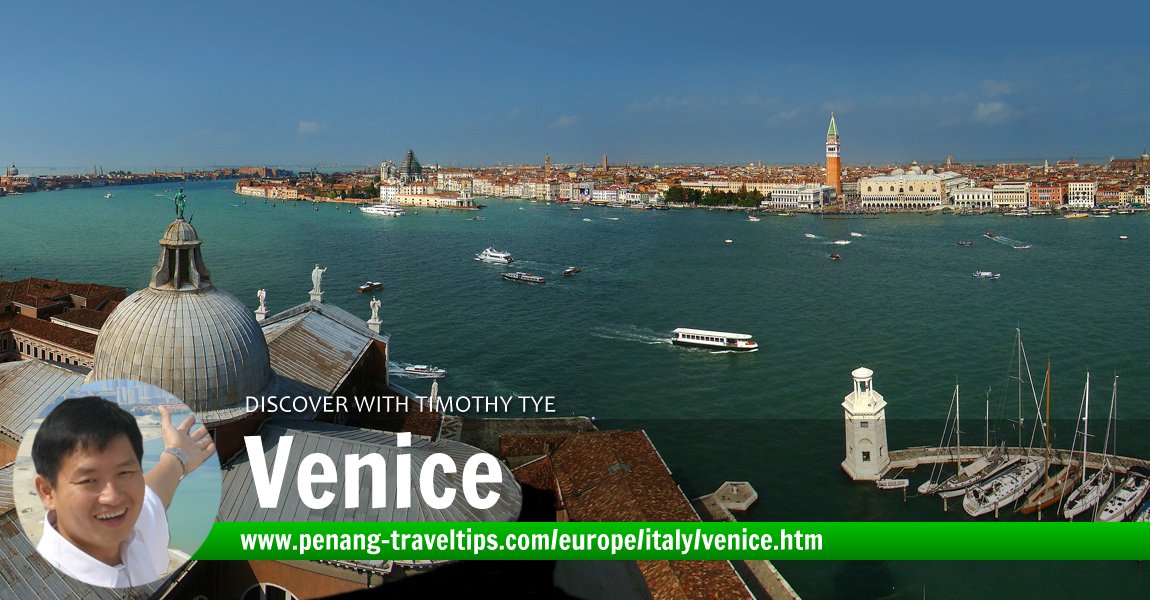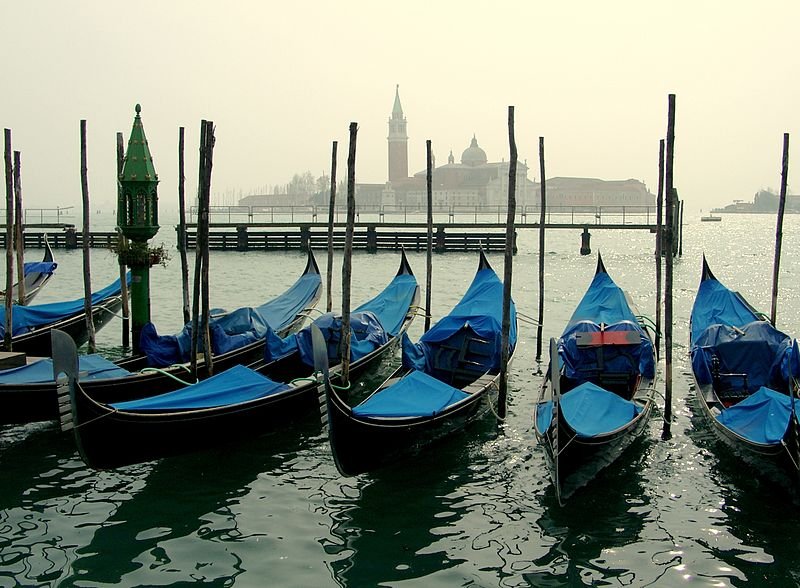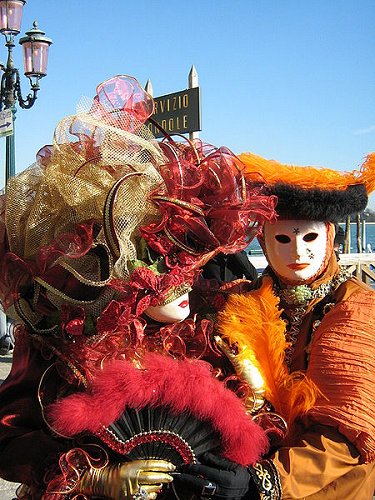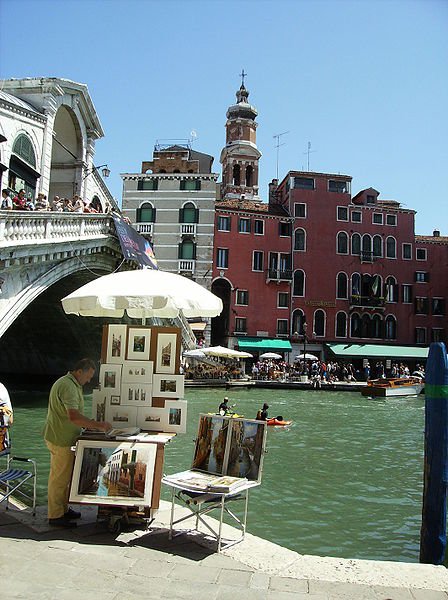 Campanile of San Giorgio Maggiore Basilica, Venice
Campanile of San Giorgio Maggiore Basilica, VeniceSource: https://en.wikipedia.org/wiki/File:Veneto_Venezia1_tango7174.jpg
Author: Tango7174

Venice is a travel guide with information and tips to help you get to know and plan your visit to Venice, Italy. Venice is a maritime city of 272,000 people on the northeast coast of Italy. It is the capital of the Veneto, the region surrounding it. Together with Padua, it forms a metropolitan area with a population of 1.6 million people.
The city of Venice sits on the marshy Venetian Lagoon on the coast of the Adriatic Sea, between the estuaries of the Po and Piave rivers. The city itself was built on islands in the lagoon. It is stitched together by bridges that cross many intertwining canals cutting across the city.
First time visitors to Venice are often surprised to find the hordes of tourists flooding its narrow alleys. Indeed, being one of Italy's top tourist destination, Venice gets quite crowded for most times of the year, and during some peak periods, there is barely standing room in the heart of the city, at St Mark's Square. Wandering away from the square, you will fine the crowds petering out, eventually leaving you to explore the alleyways at your own pace.
Main Tourist Attractions of Venice
Members' Travel Shots of Venice
- ChyeLim Lee posted on Venice on 17 September, 2019
- ChyeLim Lee posted on Venice on 17 September, 2019
- ChyeLim Lee posted on Grand Canal, Venice on 17 September, 2019
- ChyeLim Lee posted on Grand Canal, Venice on 17 September, 2019
- ChyeLim Lee posted on Grand Canal, Venice on 17 September, 2019
- ChyeLim Lee posted on Grand Canal, Venice on 17 September, 2019
- ChyeLim Lee posted on Basilica di Santa Maria della Salute, Venice on 17 September, 2019
 Gondolas with the Church of San Giorgio Maggiore in the background
Gondolas with the Church of San Giorgio Maggiore in the backgroundSource: https://commons.wikimedia.org/wiki/File:San_Giorgio_Maggiore_with_gondolas.jpg
Author: Mestska

 Carnival in Venice
Carnival in VeniceSource: https://commons.wikimedia.org/wiki/File:Carnaval_Venecia_14feb2009.jpg
Author: Robertito1965

Venice on Google Maps Street View
History of Venice
Many historians believe - as no historical records exist - that the area of Venice was first settled by refugees who left Roman cities such as Padua, Aquileia, Treviso, Altino and Concordia following successive attacks by Germanic tribes and Huns. Tradition holds that the city dates from the founding of its first church, the San Jacopo on the islet of Rialto around AD 421.By the 12th century, Venice has developed into a powerful merchant city. Its location at the head of the Adriatic Sea made it a major naval and commercial power. It was the gateway for goods coming in from Byzantine Empire and the Islamic world heading for the rest of Western Europe. To strengthen its position and also to overcome pirate menace, Venice set up military stations in a number of locations along the eastern shores of the Adriatic coast. The city forged a close relationship with Constantinople, and in return for helping the Eastern Roman Empire resist Norman and Turkish incursions, was twice granted trading privileges with it.
 Sidewalk vendor near the Rialto Bridge
Sidewalk vendor near the Rialto BridgeSource: https://commons.wikimedia.org/wiki/File:Rialto_from_riva_del_vin.JPG
Author: Abxbay

By the 13th century Venice was the richest city in Europe. It was governed by the Great Council composed of members drawn from its noble families. The Great Council welded enormous power. It appointed all of the public officials running the city as well as elect a Senate comprising 200 to 300 members. Heading the Great Council is a Doge, or duke, who is the ceremonial head of the city, a position held for life.
The decline of Venice began in the 15th century, following its unsuccessful attempt to defend Thessalonica against the Ottomans. It also sent ships to defend Constantinople against the Turks, but despite a costly campaign, it fell to Sultan Mehmet II, who promptly declared war against Venice. This war lasted thirty years and caused the city to lose much of its eastern Mediterranean territories. Meanwhile the discovery of the New World by Christopher Columbus and a new sea route to India further eroded Venice's trade monopoly. As a result, it was left behind in the race to colonize the world.
The weakened city was devastated by the Black Death, in 1348 and again between 1575 and 1577. Another plague in 1650 killed off a third of the city's population of 150,000. By then the severely weakened city was losing its position as an international emporium, just as newcomer Portugal was becoming Europe's main trading nation with the Far East and the Americas.
 The Grand Canal of Venice
The Grand Canal of VeniceSource: https://commons.wikimedia.org/wiki/File:Grand_Canal-Venice.jpg
Author: Yair Haklai

After 1100 years as an independent republic, Venice fell into the hands of Napoleon Bonaparte on 12 May 1797. Five months later, Napoleon signed the Treaty of Campo Formio, giving Venice to the Austrians, who occupied it until 1805, when it became part of Napoleon's Kingdom of Italy. The defeat of Napoleon in 1814 brought Venice back under Austrian control, as part of the Austrian-controlled Kingdom of Lombardy-Venetia. In 1849, a revolt help Venice regain its independence, as the reestablished Venetian Republic. It later became part of a newly created Kingdom of Italy following the Third Italian War of Independence of 1866.
Venice was relatively unaffected by the Second World War. Its industrial areas in Mestre and Marghera suffered repeated bombings as were the train lines to Padua.
English names or Italian?
In writing this website, I am repeatedly confronted with the issue of whether to call the many sights by their original Italian name or should I use the name as they are known in English. My decision is to judge whether the site is more popularly known by which name. If it is well known by the English name, then that's the name I will use, but I will also mention its original Italian name. Sights which are not commonly known in English appear in their original Italian.Living in Venice
Take your time choosing from the many Venice apartments to rent to make sure you get the best views and the ideal location during your stay. This unique Italian city has enjoyed a continued flurry of tourism who come to enjoy those trademark rides on a Gondela.Sestieri of Venice
Venice is divided into six neighbourhoods called sestieri. Here's how you can explore them one by one.- Cannaregio
The northernmost and most populous sestiere of Venice. - Castello
The easternmost sextiere of Venice. - Dorsoduro
The largest sestiere of Venice. - San Marco
The sestiere in the heart of Venice, and includes the island of San Giorgio Maggiore. - San Polo
The smallest sestiere of Venice. - Santa Croce
Sestiere on the north west of the main islands of Venice.
Places around Venice
- Isola di San Servolo
Small island in the Venetian Lagoon, to the southeast of San Giorgio Maggiore. - La Certosa
Island in the Venetian Lagoon, to the northwest of Venice. - Lido di Venezia
Sandbar to the east of Venice, venue of the Venice Film Festival. - Mestre
City on the coast of mainland Italy overlooking Venice. - Murano
Island to the north of the main of Venice, famous for its glassware. - Sacca Sessola
Man-made island to the south of Venice. - Sant'Erasmo
Island to the east of Vignole in the Venetian Lagoon. - Venetian Lagoon
Enclosed bay that surrounds Venice, with a number of small islands. - Veneto
Region of Italy to which Venice belongs, and serves as its capital. - Vignole
A group of two islands to the east of Venice.
 Latest updates on Penang Travel Tips
Latest updates on Penang Travel Tips

Copyright © 2003-2025 Timothy Tye. All Rights Reserved.

 Go Back
Go Back